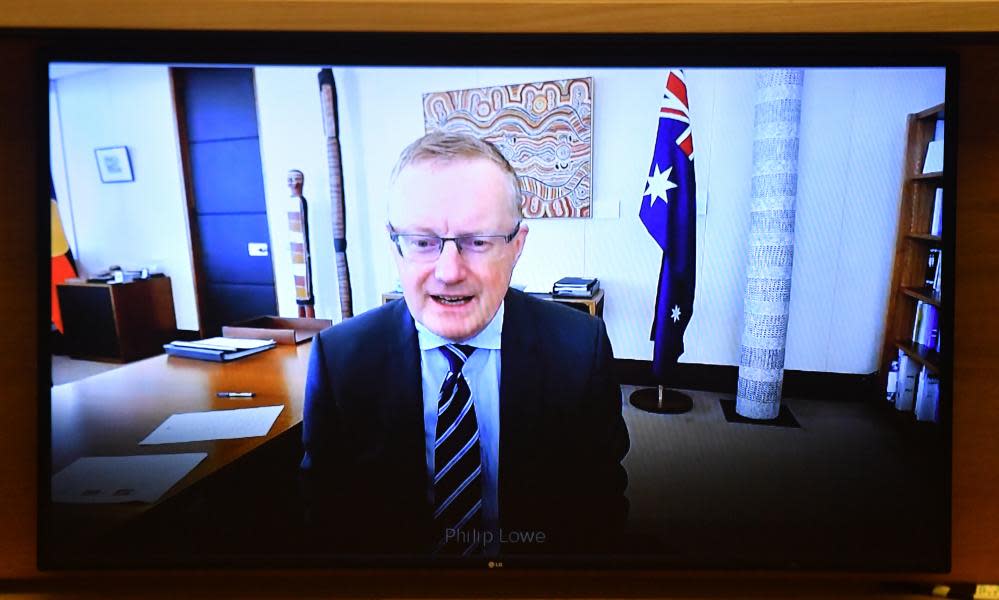Australia should borrow at today's low rates to pay for job creation – RBA chief

The federal government should borrow now while interest rates are at historic lows to pay for the job creation needed to combat soaring unemployment in a coronavirus-ravaged economy, the Reserve Bank of Australia governor, Philip Lowe, has said.
Appearing before a parliamentary inquiry on Friday, Lowe painted a grim economic picture, saying recovery would be delayed because of a second wave outbreak in the country’s second-biggest state, Victoria.
Lowe said unemployment would peak at 10% towards the end of this year but would remain persistently high, at 7%, for “several years”.
“In our baseline scenario, we are expecting the Australian economy to contract by around 6% this year, and then grow by 5% next year and 4% in 2022,” he said.
He also admitted the bank had no hope of meeting its inflation target of between 2% and 3% in the next few years, with inflation to remain stuck at between 1% and 1.5%.
Australians who remain in work will not receive pay rises in excess of inflation over the same period, he said.
Related: More than one million Australians out of work as unemployment rate edges up to 7.5%
Despite the widespread economic devastation, Lowe repeated his opposition to both negative interest rates, which he said would hurt the profits of private banks, and directly financing spending by printing money, which he derided as involving a “free lunch”.
In one extraordinary exchange, he also said that Australia’s heavily indebted households could both pay down their debts and boost the economy by increasing their spending.
Lowe said things were better than they would have been without the federal government’s jobkeeper package and intervention by the RBA to prop up the banks.
“We are expecting the published unemployment rate to decline gradually from 10%, but to still be around 7% in a few years’ time,” Lowe said.
He heaped pressure on the government to tip more money into the economy.
“Looking forward, an important priority will be to boost jobs,” he said.
“Based on the forecast I discussed earlier, high unemployment is likely to be with us for some time, which should be a concern for us all.
“The Reserve Bank will do what it can with its policy instruments to support the journey back to full employment. Beyond that, government policies that support people’s incomes, that add to aggregate demand through direct government spending and that make it easier for firms to hire people all have important roles to play.”
Lowe was challenged by Labor’s shadow assistant treasurer, Andrew Leigh, over his failure since he was appointed in 2016 to bring inflation up to the RBA’s target band of between 2% and 3%.
Leigh pointed out that it was now likely that Lowe would do two terms as governor without once hitting the target.
“Wouldn’t a year of negative rates be better than a decade of zero rates?” Leigh asked.
“I don’t rule it out but it’s extremely unlikely,” Lowe said.
He said the benefit would be that the currency would fall, making Australian exports more competitive.
But Lowe said a negative cash rate would impair the profitability and efficiency of the banks, impairing their ability to provide credit.
He also claimed that negative rates would encourage people to save more, even though they would be getting less back than they put in.
Leigh accused him of putting bank profits before jobs. “That seems like a mistaken call,” he said.
Lowe’s statement on savings also seemed to conflict with his previous evidence to the committee, Leigh said.
Lowe wasn’t able to point to any solid evidence for the proposition.
“It’s an emerging area of research,” he said.
“My concern, at least at the moment, is that negative interest rates would make credit supply more difficult, and that would hurt jobs.”
Banks have continued to make profits during the crisis, thanks in part to generous support from the RBA.
NAB today announced a $1.5bn profit for the three months to the end of June, and earlier this week the CBA unveiled a full-year cash profit of $7.3bn, down 11.3% from the previous year.
In a blow for modern monetary theory fans, Lowe also ruled out the use of money printing to directly finance the federal budget.
“For some, this offers the possibility of a ‘free lunch’,” he said.
“The reality, though, is that there is no free lunch. There is no magic pudding. There is no way of putting aside the government’s budget constraint permanently.”


